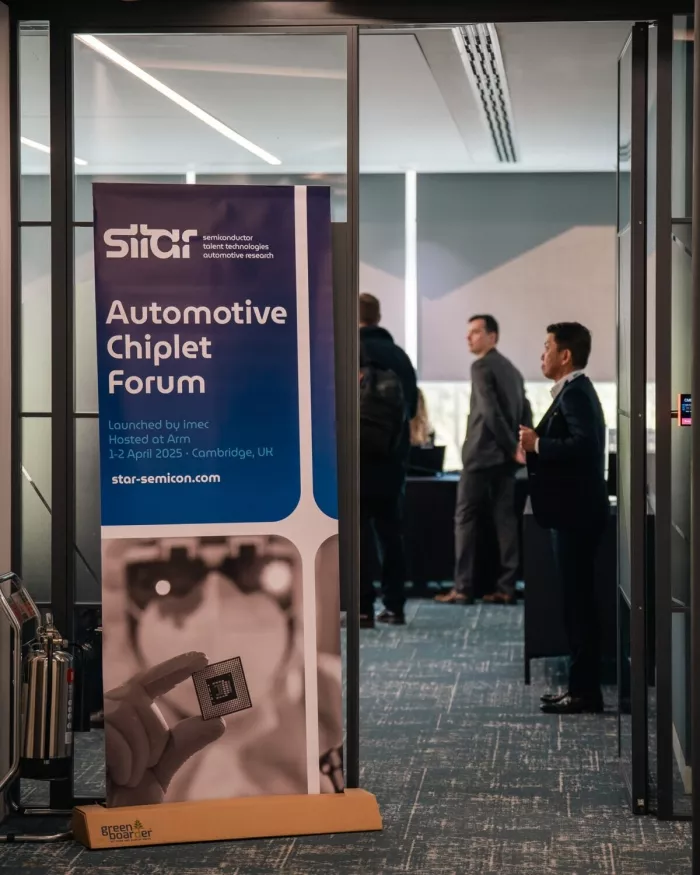Why Chiplets Are Key to Next-Gen Software-defined Vehicles
Chiplets are a modular approach to silicon design that benefit automotive technologies by enhancing scalability, cost efficiency, and performance.
Co-authored by Suraj Gajendra, Vice President, Automotive Products and Solutions, Arm, and Bart Placklé, Vice President, Automotive, at imec.
The automotive industry is undergoing a profound transformation as part of its shift towards the next-generation of sophisticated, software defined vehicles (SDVs). This is leading to the consolidation of a wide range of on-board electronic components into a smaller number of high-performance compute elements. However, the rapid evolution of automotive technology presents a growing challenge – how to deliver the necessary computational power in a resource-efficient and cost-effective manner.
Traditional monolithic semiconductor designs are reaching their limits. The rising demand for autonomous driving, immersive infotainment, and enhanced connectivity is stretching conventional chip architectures to their breaking point.
Fortunately, there is a solution through chiplets that address these challenges. Within the automotive industry, chiplets are already emerging as a key technology to enable innovative new system-on-chip (SoC) designs for automotive silicon, while enhancing compute scalability and flexibility.
Why chiplets matter for the automotive industry
Automotive leaders are already actively investing in next-generation vehicle architectures that are expected to benefit from chiplet integration. This is being driven by recent trends and developments in the automotive industry, including:
- Centralized compute architectures: The industry is transitioning to centralized architectures with a few high-performance computing units. This centralization of compute power enables the adoption of advanced chiplet architectures in automotive applications.
- The rise of AI: With AI-driven decision-making becoming critical for autonomous driving, chiplets allow OEMs to decouple innovation cycles, ensuring that their platforms remain adaptable to future advancements.
- Performance scaling: As vehicles incorporate more advanced features, the demand for higher computational capabilities has surged. Chiplets facilitate performance scaling by allowing integration of specialized processing units without redesigning entire systems.
- Standardization efforts: Industry-wide initiatives, such as the Arm Chiplet System Architecture (CSA) and imec’s Automotive Chiplet Program (ACP), are setting new benchmarks for chiplet interoperability. Standardized interfaces will be key to ensuring widespread adoption and reducing integration complexity.
At the same time, traditional systems that are reliant on monolithic chips often struggle to meet the escalating demands for computational power, scalability, and efficiency, with key challenges including:
- Increasing system complexity: As vehicles become more software-driven, traditional semiconductor architectures cannot keep up with the growing need for real-time data processing and AI-driven decision-making.
- Manufacturing bottlenecks: The slowdown of Moore’s Law has made it more expensive and difficult to scale performance using traditional SoCs.
- Reliability concerns: With mission-critical automotive applications, fault isolation and redundancy are more challenging to implement in monolithic designs.
A new way to build silicon
Foundational computing flexibility enables automotive OEMs to drive innovation, allowing them to develop tailored solutions that evolve with technological advancements. Announced in March 2024, Arm’s Compute Subsystems (CSS) for Automotive offers a faster path to building chiplet-based designs through enhanced computing and integration capabilities. This modular approach also allows OEMs and silicon providers to customize and scale their automotive technologies to meet specific regional requirements and evolving global regulations.
Additionally, chiplets offer numerous intriguing SoC design possibilities for the ecosystem. Through our Automotive Enhanced (AE) technologies, Arm is enabling partners to integrate multiple reusable components into larger automotive systems, showcasing the adaptability and scalability the Arm compute platform.
imec’s Automotive Chiplet Program
“Chiplets are the answer to the automotive industry’s evolution, offering the flexibility and scalability needed to create innovative SoC architectures that can meet the growing demands of next-gen vehicles.” – Bart Placklé, vice president, automotive at imec.
Adopting chiplet technologies represents a disruptive shift in central vehicle computer design. At the same time, transitioning to chiplet-based architectures can be prohibitively expensive for automotive OEMs if undertaken in isolation. With the aims of fostering collaboration across the automotive ecosystem and exploring the benefits of chiplets, imec launched the ACP in late 2024. This initiative has gained significant traction, expanding to include key automotive industry leaders including: Arm, ASE, BMW Group, Bosch, Cadence Design Systems, Siemens, SiliconAuto, Synopsys, Tenstorrent, and Valeo.
By bringing together semiconductor vendors, electronic design automation (EDA) organizations, and Tier 1 suppliers, the program is working to address the key technical challenges and explore practical use cases for chiplets in automotive applications. This progress also signals a paradigm shift in the industry, which is moving from a pre-competitive phase of research and exploration into an implementation phase where automotive companies are starting to put chiplet-based designs into practice.
Imec’s ACP has already paved the way by pooling resources and expertise from across the automotive value chain to tackle key technical challenges and identify optimal chiplet architectures for high-performance automotive computing. The next step in this journey is the development of a chiplet-based reference design, based on advancements from the ACP. In partnership with the State Government of Baden-Württemberg, Germany, imec has launched the Advanced Chip Design Accelerator (ACDA) at the Innovation Park Artificial Intelligence (IPAI) in Heilbronn. This new competence center will focus on developing cutting-edge chiplet technologies, system integration, packaging, and AI capabilities, all with the goal of building pre-competitive reference designs to accelerate and de-risk migration to chiplets.
The ACDA will play a critical role in accelerating the deployment of chiplet-based solutions in the automotive sector, ensuring the smoother integration and faster adoption of chiplet technologies, and reducing risks and time-to-market for automotive manufacturers.

imec’s Automotive Chiplet Forum
At its Automotive Chiplet Forum (ACF) hosted in Arm’s global HQ in Cambridge, imec announced that there will be new members of the ACP. This highlights the growing momentum behind the ACP and chiplet technologies in the automotive industry. In fact, the key takeaway from the event, which was attended by over 120 people from across the automotive and semiconductor industry, was the need to move at pace to accelerate the ongoing development and deployment of chiplet technologies. Alongside the ACP, industry-wide standards, like the Universal Chiplet Interconnect Express (UCIe) and CSA, will be essential if chiplets are to scale across the automotive industry. These will be the foundation of new enabling technologies, like the Arm CSS for Automotive, that will help to accelerate the development and deployment of chiplets.
The partnerships formed today will drive tomorrow’s innovations
The automotive industry stands at the cusp of a fundamental transformation, and chiplets are the building blocks of this new era. This will redefine how vehicles are built, customized, and enhanced, with automakers having the power to innovate without limitations, thanks to the foundational flexibility enabled by chiplets.
The journey towards chiplet adoption across the automotive industry is a collective endeavour. The partnerships formed today through programs and initiatives like the ACP will drive the innovations of tomorrow, developing vehicles that are smarter, safer and adaptable to the ever-evolving demands of consumers.
Related Chiplet
- Interconnect Chiplet
- 12nm EURYTION RFK1 - UCIe SP based Ka-Ku Band Chiplet Transceiver
- Bridglets
- Automotive AI Accelerator
- Direct Chiplet Interface
Related Blogs
- What are Chiplets? - The Key Technology Behind Next-Gen Semiconductor Manufacturing
- The Automotive Industry's Next Leap: Why Chiplets Are the Fuel for Innovation
- Chiplets: an opportunity to rethink vehicles
- Chiplets Turn 10: Here are Ten Things to Know
Latest Blogs
- Thermal Management in 3D-IC: Modeling Hotspots, Materials, & Cooling Strategies
- 3D Chips: Socionext Achieves Two Successful Tape-Outs in Just Seven Months
- Intel Foundry Collaborates with Partners to Drive an Open Chiplet Marketplace
- 3D-IC Packaging: Wafer Stacking, Hybrid Bonding, and Interposer/RDL Techniques
- Through-Silicon Vias (TSVs): Interconnect Basics, Design Rules, and Performance
